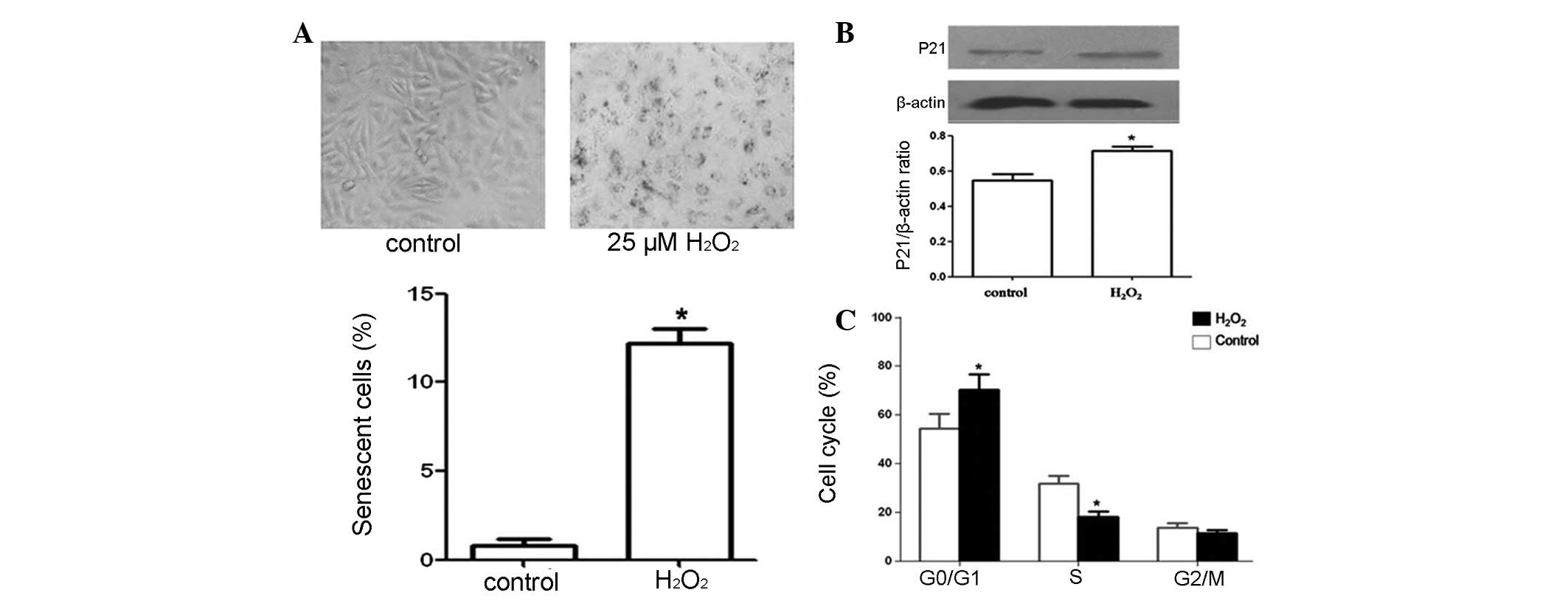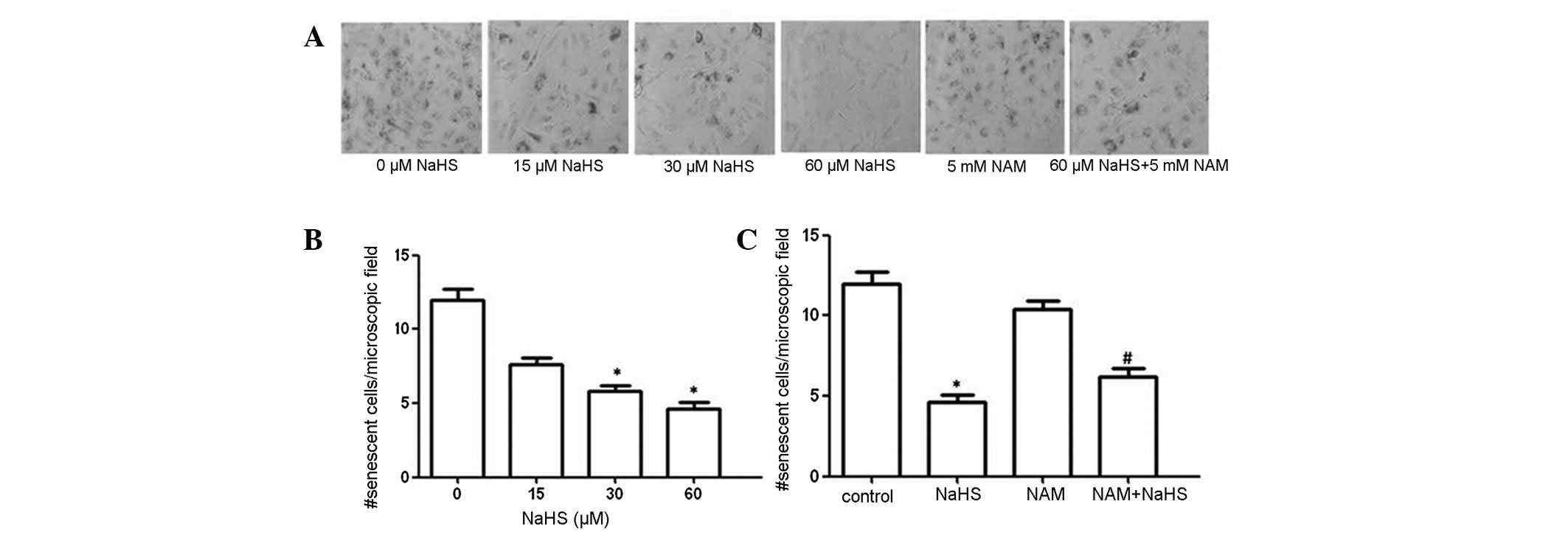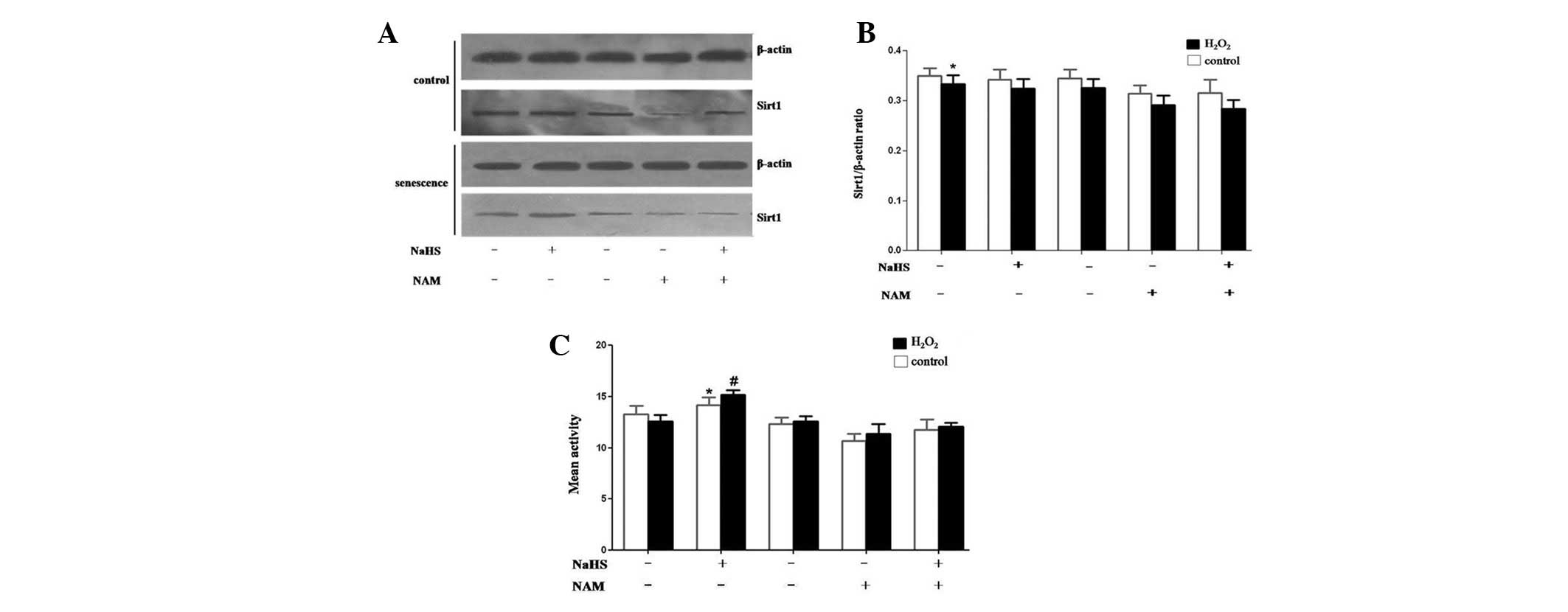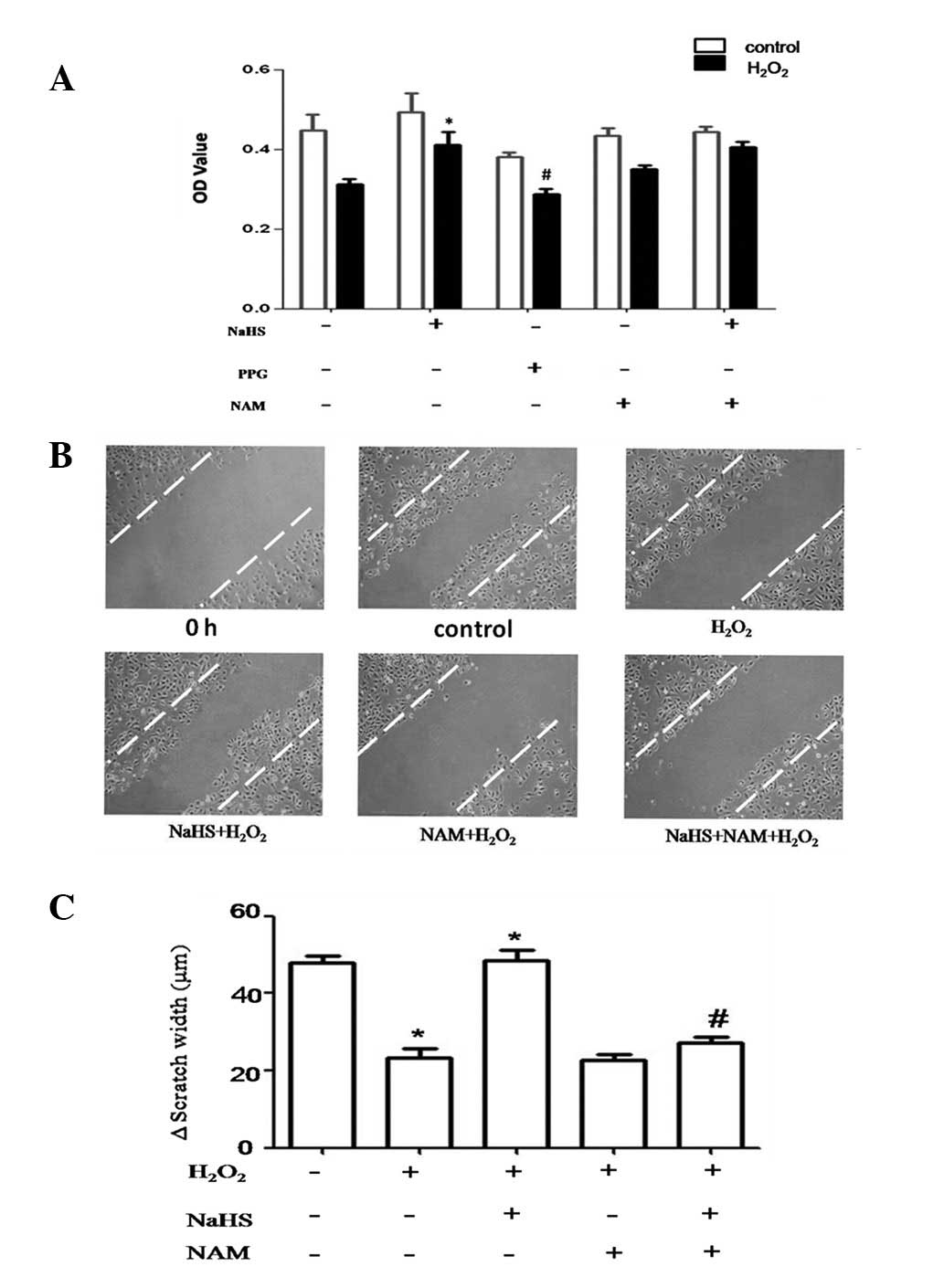Hydrogen sulfide prevents H2O2-induced senescence in human umbilical vein endothelial cells through SIRT1 activation
- Authors:
- Published online on: April 9, 2013 https://doi.org/10.3892/mmr.2013.1417
- Pages: 1865-1870
Abstract
Introduction
During aging, a number of physiological functions are altered and the cessation of cell division is accompanied by specific changes in cell function, morphology and gene expression. These changes may contribute to age-associated diseases, including hypertension, chronic coronary disease and diabetes (1). Vascular endothelial cells (VEC) are highly specialized and active cells exhibiting antithrombotic and anti-inflammatory properties. These cells are critically involved in the maintenance of vascular homeostasis by regulating vascular tone and integrity, as well as remodeling processes (2). Vascular cell senescence, which accompanies aging, promotes endothelial cell dysfunction (3) and is associated with increased vascular risk (4). Pathological states, including those observed in oxidative stress conditions, invoke irreversible growth arrest in vitro within a few days, a term referred to as stress-induced premature senescence (SIPS) (5,6). Previous evidence suggests that premature senescence of endothelial cells may lead to endothelial dysfunction and atherogenesis (3).
Hydrogen sulfide (H2S) has attracted considerable interest as an endogenous gaseous mediator and potential pharmacological/therapeutic tool. It is endogenously generated from cysteine, in reactions catalyzed by cystathionine β-synthase (CBS) or cystathionine γ-lyase (CSE) (7). Studies in various species, including humans have demonstrated that H2S is involved in diverse physiological and pathophysiological processes, including regulation of blood pressure (8), inflammation (9) and metabolic disorders (10). The beneficial effects of H2S may be mediated through its antioxidant effects. H2S is a potent inhibitor of O2- formation and gp91phox expression induced by TNF-α in pulmonary artery endothelial cells (PAECs) (11). Furthermore, H2S protects endothelial cells against oxidized low-density lipoprotein (LDL) and hydrogen peroxide (H2O2)-mediated cell cytotoxicity (12). H2S also appears to be a potent scavenger of oxygen-derived free radicals (13), which may contribute to the protective role of NaHS against the toxicity of H2O2in vitro and in vivo(14). Findings of a previous study from our laboratory indicated that the endogenous CSE/H2S system is downregulated in adipose tissues during aging (15). Another study reported that thermotolerance and lifespan of Caenorhabditis elegans (C. elegans) was increased when exposed to H2S, which was mediated by SIR-2.1 activity (16).
SIR-2.1 is a C. elegans ortholog to sirtuin 1 (SIRT1), which is commonly known as nicotinamide adenine dinucleotide (NAD+)-dependent class III histone deacetylase. This enzyme has been shown to modulate lifespan in yeast, worms, flies and mice. A mammalian SIRT1 homolog, silent information regulator-2 (Sir2), is highly conserved in organisms ranging from archaea to humans and it has been shown to regulate cell cycle, senescence, apoptosis and metabolism by interacting with a number of molecules, including p53 (17) and Foxo1 (18). A previous study demonstrated that SIRT1 inhibition induces premature senescence-like growth arrest in human cancer cells (19). The aim of the present study was to investigate the effects of H2S, using the donor NaHS, on the inhibition of H2O2-induced senescence in human umbilical vein endothelial cells (HUVECs) and the role of SIRT1 in this process.
Materials and methods
Materials
3-(4,5-Dimethylthiazol-2-yl)-2,5-diphenyl-tetrazolium bromide (MTT), dimethyl sulfoxide (DMSO), collagenase II, sodium hydrosulfide (NaHS) and DL-propargylglycine (PPG) were purchased from Sigma Aldrich (Zwijndrecht, Netherlands). Endothelial cell growth supplement (ECGS) was purchased from ScienCell Research Laboratories, Inc. (Carlsbad, CA, USA). p21 and SIRT1 antibodies and the Senescence β-Galactosidase Staining Kit were purchased from the Beyotime Institute of Biotechnology (Shanghai, China). Luminol reagent and polyvinylidene fluoride (PVDF) membranes were purchased from Millipore (Billerica, MA, USA).
Cell cultures
HUVECs were isolated from newborn umbilical cords and cultured in M199 (Gibco, Grand Island, NY, USA) supplemented with 20% fetal bovine serum (FBS) and 2% EGCS at 37°C under 5% CO2 in a humidified atmosphere. Cells were used during passages two or three.
Immunohistochemistry
Immunohistochemical staining of the HUVECs for factor VIII-like antigen (fVIII-AGN) was performed on confluent cultures grown in 35-mm dishes. The media was aspirated and the cells were washed with phosphate-buffered saline (PBS) prior to fixing in bovine serum albumin (BSA) for 15 min at room temperature. The cells were washed again with PBS and incubated with a 1:40 (v/v) dilution of horseradish peroxidase (HRP)-conjugated rabbit anti-human fVIII:AGN (Bioss Inc., Woburn, MA, USA) for 45 min. The dishes were washed in triplicate with PBS, rinsed briefly with distilled water and mounted with buffered glycerol on glass cover slips. HRP-bound primary antibody was detected and observed using 3,3′-diaminobenzidine (DAB). Smooth muscle cells served as negative controls.
Senescence-associated β-galactosidase (SA-β-gal) staining
SA-β-gal activity was measured using a senescence cell staining kit. HUVECs were pretreated with various concentrations of NaHS, 5 mM NAM or a combination of NaHS and NAM for 48 h. The cells were then placed in media supplemented with 25 μM H2O2 for 1 h. The media were then replaced with normal medium and incubated for an additional 72 h. The cells were washed twice with PBS and the HUVECs were fixed and stained for SA-β-gal activity using the Senescence β-Galactosidase Staining Kit. The cells were then incubated at 37°C for 16 h and SA-β-gal-positive cells were observed using microscopy, which included counting >400 cells in three independent fields. The percentage of SA-β-gal-positive cells was determined by counting the number of green cells within a sample (20).
Cell cycle assay
To determine the effect of H2O2 on cell cycle progression, HUVECs were grown for 1 h with or without 25 μmol/l H2O2. Cells were collected using trypsinization and centrifugation for 5 min at 300 × g and were fixed with 70% ethanol at 4°C overnight. Cells were centrifuged to remove alcohol, stained with 50 mmol/l propidium iodide and washed twice with cold PBS. HUVECs were subjected to flow cytometric analyses with FACSCalibur and CellQuest software (BD Biosciences, Franklin Lakes, NJ, USA). Cell cycles were analyzed and the proportion of cells in the G0/G1, S and G2/M phases was recorded.
Immunoblot analyses
Protein extracts were prepared using the mammalian cell extraction kit following the manufacturer’s instructions. Protein concentrations were determined using a BCA Protein Assay kit (Pierce, Biotechnology, Inc., Rockford, IL, USA). Extracted proteins were treated with 5% sodium dodecyl sulfate-polyacrylamide gel electrophoresis (SDS-PAGE) sample buffer, then heated at 100°C for 10 min and separated using electrophoresis on a 10% SDS-polyacrylamide gel. Equal amounts of protein were separated using SDS-PAGE and then transferred to PVDF membranes. The membranes were incubated in a blocking buffer containing BSA (1%) and Tween-20 (0.1%, v/v) in Tris-buffered saline with Tween-20 (TBST) at room temperature for 2 h, and inoculated overnight at 4°C with the primary antibodies, anti-human β-actin (1:500) and anti-human SIRT1 (1:300). The membranes were then inoculated with goat anti-rabbit (1:3,000) and goat anti-mouse (1:1,500) HRP-conjugated secondary antibodies at room temperature for 2 h. Each membrane was developed using enhanced chemiluminescence detection and quantified by densitometry.
Enzymatic activity assay
A SIRT1 enzyme activity assay was performed to determine the effect of H2S on activity using a commercially available kit (Genmed, Plymouth, MN, USA). After preparing cell lysates, the SIRT1 activity assay was performed in a 96-well plate according to the manufacturer’s instructions. The reaction product emitted fluorescence, which was detected using an excitation wavelength of 350 nm and an emission wavelength of 405 nm.
Cell proliferation assay
Proliferation of HUVECs was determined using an MTT assay (21). Forty-eight hours after cell seeding, the media were removed and 210 μl fresh culture media and 50 μl MTT solution (5 mg/ml in PBS) were added to each well, followed by incubation for 2 h at 37°C in a 5% CO2 atmosphere. The cells were cultured for 4 h at 37°C in a 5% CO2 atmosphere and the optical density of the solution was evaluated using a microplate spectrophotometer at 595 nm.
Cell scratch assay
To determine the functional consequences of senescence induced by H2O2, the in vitro scratch injury model was used. Cells were seeded in a 96-well plate and treated 24 h after seeding. Twenty-four hours after treatment, a thin-line, devoid of cells, was made by scratching the culture plate bottom with a 10 μl pipette tip. Following scratching, the wells were washed with PBS and fresh media were added. Two images were captured per well; the width of the scratch was measured at four points per image with Image-Pro Plus and the means were calculated.
Statistical analyses
Results are expressed as mean ± standard error of the mean (SEM) or mean ± standard deviation (SD). Differences between groups were evaluated using analysis of variance, Dunnett’s test or the least significant difference t-test. P<0.05 was considered to indicate a statistically significant difference.
Results
Establishing a senescence model in HUVECs
To investigate the effect of H2S on HUVEC senescence, we utilized an established senescence model, which involved incubating the cells with 25 μmol/l H2O2 for 1 h (22). Using light microscopy, we confirmed the presence of senescent HUVECs, which exhibited increased cell size and cytoplasmic granularity (Fig. 1A). The number of SA-β-gal-positive cells (Fig. 1A) and the proportion of HUVECs in the G0/G1 phase (Fig. 1C) were increased, indicating the presence of senescent cells. In order to confirm our results, we investigated p21 levels, which were increased in senescence (23). Immunoblot analyses indicated that p21 levels were increased in HUVECs treated with H2O2 (Fig. 1B). Collectively, these results indicate that the low concentration of H2O2 used in our study induced cell senescence.
H2S protects against HUVEC senescence
SA-β-gal is a well-accepted biochemical marker of cell senescence (24). Examination of SA-β-gal activity in HUVECs treated with H2O2 (25 μM) revealed a significant increase in SA-β-gal-positive cells, which reached 11.2±1.06% (Fig. 1A). However, increases in SA-β-gal-positive cells were significantly attenuated in the NaHS (60 μM) group (Fig. 2A and B).
Progression through the cell cycle is a critical cellular process and cell cycle arrest during the G1 phase is a characteristic exhibited by senescent cells. Our results demonstrated that treatment with 25 μM H2O2 arrested HUVECs in the G0/G1 phase as the proportion of cells in the G0/G1 phase was ~70.2% compared to 54.4% in the control group. NaHS (60 μM) pretreatment eliminated the effects of H2O2 and reduced the proportion of cells in the G0/G1 phase to 58.1% (Table I). These results indicate that H2S protects against HUVEC senescence.
H2S enhances the activation of SIRT1
To determine whether H2S regulates HUVEC senescence through a SIRT1-mediated pathway, we examined the expression and activity of SIRT1. Immunoblot analyses indicated that SIRT1 levels were decreased in the H2O2 (25 μM) treatment group compared to the control, and NaHS (60 μM) treatment did not rescue SIRT1 expression (Fig. 3A and B). In contrast to its effect on protein expression, NaHS enhanced SIRT1 deacetylase activity in vitro (Fig. 3C), indicating a direct effect on SIRT1-mediated pathways. These results suggest that NaHS blocks senescence, cell differentiation and stress-induced apoptosis, and promotes cell growth by increasing SIRT1 deacetylase activity.
Inhibition of SIRT1 by NAM attenuates the anti-senescent effects of H2S
To elucidate the role of SIRT1, HUVECs were pretreated with NaHS and/or NAM, a selective SIRT1 inhibitor, for 48 h prior to treatment with H2O2 (25 μM) for 1 h. NAM attenuated the decrease in SA-β-gal-positive cells inferred by NaHS alone (Fig. 2A and C).
H2S prevents H2O2-mediated dysfunction in HUVECs
Since cell cycle arrest is a common hallmark of cellular senescence, we examined cell proliferation using the MTT assay. Our study indicated that NaHS (60 μM) improved H2O2-induced decreases in HUVEC proliferation. This reduction in proliferation was similar, but not significant, in cells pretreated with NAM and NaHS. Treatment with NaHS alone, however, was effective at rescuing the anti-proliferative effects of H2O2 (Fig. 4A). To further examine whether H2S attenuates senescence-induced endothelial cell dysfunction, we monitored cell migration using a scratch assay (25). Cell migration was significantly reduced by H2O2 and pretreatment with NaHS eliminates this decrease. However, pretreatment with NAM and NaHS was associated with significantly decreased cell migration, which is similar to that observed in cells treated with H2O2 (Fig. 4C). We conclude that H2S prevents the reduction in cell migration associated with senescence, an effect that is prevented by NAM. These results indicate that H2S protects HUVECs against senescence through SIRT1.
Discussion
A number of studies have suggested that aging is an independent risk factor for the development of cardiovascular diseases. Previous studies further demonstrated that cellular senescence is involved in various pathological conditions, which are not limited to the cardiovascular system (26). Cellular senescence is a process by which cells irreversibly exit the cell cycle and cease to divide in response to a variety of stresses, including those observed during oxidative states (27). In this study, we established an H2O2-induced senescent model in vitro using HUVECs to investigate the protective role of H2S in cell senescence.
Results of the present study demonstrated that a dose of 25 μM H2O2 increased the number of SA-β-gal-positive cells, which was eliminated following treatment with the H2S donor, NaHS. These results demonstrated the importance of H2S in preventing HUVEC senescence. The results obtained during cell cycle analyses were consistent with this observation. Coincidently, previous studies have shown that H2S increases the lifespan in C. elegans(16). Our results suggest that H2S may be responsible for retarding the aging process. Furthermore, we explored the mechanism of H2S against HUVEC senescence.
The results of our study indicated that SIRT1 expression was unchanged after HUVECs were pretreated with 60 μM NaHS for 48 h, while SIRT1 enzyme activity was enhanced, indicating that SIRT1 is a key sensor system for regulating endothelial cell survival, proliferation and senescence. A recent study suggested that SIRT1 overexpression in a mouse model led to a significant improvement in animal health during aging (28). Another study demonstrated that the protective effects of SIRT1 may be due to the regulation of acetylation/deacetylation of key proteins (29). One study indicated that SIRT1 protein levels decrease rapidly with each increase in cell passage and this leads to premature senescence (30). SIRT1 protein stability may play a role in the progressive loss of SIRT1 associated with aging; however, the mechanisms remain elusive. One study indicated that post-translational modification by sumoylation affects the activity of SIRT1 (31). Another study demonstrated that ~10–25% of liver proteins, including actin, tubulin and glyceraldehyde-3-phosphate dehydrogenase (GAPDH), undergo sulfhydration under physiological conditions. Sulfhydration appears to be a physiological post-translational modification for proteins (32). We consider that H2S may activate SIRT1 via sulfhydration of the SIRT1 protein. It is possible that SIRT1 is indirectly activated via other H2S-induced physiological alterations. The hypothesis that H2S shifts redox homeostasis, thereby increasing available NAD+ (or the NAD+/NADH ratio) and resulting in increased SIRT1 activity is controversial.
HUVEC senescence and the consequent reduction of their proliferative and migration ability may contribute to miopragia associated with advanced age. In the present study, we observed that HUVECs treated with 25 μM H2O2 have a reduced ability to migrate, while NaHS treatment prevented this process. However, the mechanisms by which H2S improves cell proliferation remain unclear. It is accepted that increased cellular senescence is associated with decreased cell proliferation in vivo since senescent cells are not able to divide (33). Therefore, it may be concluded that NaHS (60 μmol/l) improves HUVEC proliferation by delaying cell senescence.
Exogenous H2S has notable effects on mammalian physiology that improve survival in changing environmental conditions (17). Despite the molecular mechanisms involved in the modulation of SIRT1 activity, H2S affects SIRT1 activity and attenuates senescence, thus establishing that H2S exhibits novel endothelial protective effects. FoxO1, is a downstream target of SIRT1, which has been shown to modulate G1-S and G2-M phase transition by coordinating the expression of multiple important cell cycle regulators (34). In future studies, we aim to evaluate the effect of H2S on FoxO1 via SIRT1 expression and activity.
A previous study indicated that H2S-releasing diclofenac derivatives, a novel class of non-steroidal anti-inflammatory drugs (NSAIDs), may be of clinical value in the treatment of osteolytic bone disease (35). In addition, preclinical studies have indicated that the novel hydrogen sulfide-modulating agent, S-propargyl-L-cysteine (SPRC) is a potent cardioprotective candidate (36). Our study provides a novel therapeutic role for H2S, which protects against HUVEC senescence.
Acknowledgements
This study was supported by grants from the National Natural Science Foundation of China (81170277, ZS Jiang), the Special Research Fund for the Doctoral Program of Higher Education of China Project (20124324110003, ZS Jiang) and the Aid Program for Science and Technology Innovative Research Team in Higher Educational Institutions of Hunan Province.
Abbreviations:
|
H2S |
hydrogen sulfide |
|
SIPS |
stress-induced premature senescence |
|
CSE |
cystathionine γ-lyase |
References
|
Sniderman AD and Furberg CD: Age as a modifiable risk factor for cardiovascular disease. Lancet. 371:1547–1549. 2008. View Article : Google Scholar : PubMed/NCBI | |
|
Behrendt D and Ganz P: Endothelial function. From vascular biology to clinical applications. Am J Cardiol. 90:40L–48L. 2002.PubMed/NCBI | |
|
Minamino T, Miyauchi H, Yoshida T, et al: Endothelial cell senescence in human atherosclerosis: role of telomere in endothelial dysfunction. Circulation. 105:1541–1544. 2002. View Article : Google Scholar : PubMed/NCBI | |
|
Serrano AL and Andrés V: Telomeres and cardiovascular disease: does size matter? Circ Res. 94:575–584. 2004. View Article : Google Scholar : PubMed/NCBI | |
|
Gorbunova V, Seluanov A and Pereira-Smith OM: Expression of human telomerase (hTERT) does not prevent stress-induced senescence in normal human fibroblasts but protects the cells from stress-induced apoptosis and necrosis. J Biol Chem. 277:38540–38549. 2002. View Article : Google Scholar | |
|
Frippiat C, Chen QM, Zdanov S, Magalhaes JP, Remacle J and Toussaint O: Subcytotoxic H2O2 stress triggers a release of transforming growth factor-beta 1, which induces biomarkers of cellular senescence of human diploid fibroblasts. J Biol Chem. 276:2531–2537. 2001. View Article : Google Scholar | |
|
Rimondi E, di Iasio MG, Gonelli A, Celeghini C, Secchiero P and Zauli G: Hydrogen sulfide down-regulates the expression and release of osteoprotegerin (OPG) by vascular endothelial cells. Invest New Drugs. 30:1731–1735. 2011. View Article : Google Scholar : PubMed/NCBI | |
|
Lavu M, Bhushan S and Lefer DJ: Hydrogen sulfide-mediated cardioprotection: mechanisms and therapeutic potential. Clin Sci (Lond). 120:219–229. 2011.PubMed/NCBI | |
|
Predmore BL and Lefer DJ: Hydrogen sulfide-mediated myocardial pre- and post-conditioning. Expert Rev Clin Pharmacol. 4:83–96. 2011. View Article : Google Scholar : PubMed/NCBI | |
|
Whiteman M, Gooding KM, Whatmore JL, et al: Adiposity is a major determinant of plasma levels of the novel vasodilator hydrogen sulphide. Diabetologia. 53:1722–1726. 2010. View Article : Google Scholar : PubMed/NCBI | |
|
Muzaffar S, Jeremy JY, Sparatore A, Del Soldato P, Angelini GD and Shukla N: H2S-donating sildenafil (ACS6) inhibits superoxide formation and gp91phox expression in arterial endothelial cells: role of protein kinases A and G. Br J Pharmacol. 155:984–994. 2008. | |
|
Jeney V, Komódi E, Nagy E, et al: Suppression of hemin-mediated oxidation of low-density lipoprotein and subsequent endothelial reactions by hydrogen sulfide (H(2)S). Free Radic Biol Med. 46:616–623. 2009. View Article : Google Scholar : PubMed/NCBI | |
|
Geng B, Chang L, Pan C, Qi Y, Zhao J, Pang Y, Du J and Tang C: Endogenous hydrogen sulfide regulation of myocardial injury induced by isoproterenol. Biochem Biophys Res Commun. 318:756–763. 2004. View Article : Google Scholar : PubMed/NCBI | |
|
Whiteman M, Cheung NS, Zhu YZ, et al: Hydrogen sulphide: a novel inhibitor of hypochlorous acid-mediated oxidative damage in the brain? Biochem Biophys Res Commun. 326:794–798. 2005. View Article : Google Scholar : PubMed/NCBI | |
|
Feng X, Chen Y, Zhao J, Tang C, Jiang Z and Geng B: Hydrogen sulfide from adipose tissue is a novel insulin resistance regulator. Biochem Biophys Res Commun. 380:153–159. 2009. View Article : Google Scholar : PubMed/NCBI | |
|
Miller DL and Roth MB: Hydrogen sulfide increases thermotolerance and lifespan in Caenorhabditis elegans. Proc Natl Acad Sci USA. 104:20618–20622. 2007. View Article : Google Scholar : PubMed/NCBI | |
|
Luo J, Nikolaev AY, Imai S, Chen D, Su F, Shiloh A, Guarente L and Gu W: Negative control of p53 by Sir2alpha promotes cell survival under stress. Cell. 107:137–148. 2001. View Article : Google Scholar : PubMed/NCBI | |
|
Brunet A, Sweeney LB, Sturgill JF, et al: Stress-dependent regulation of FOXO transcription factors by the SIRT1 deacetylase. Science. 303:2011–2015. 2004. View Article : Google Scholar : PubMed/NCBI | |
|
Ota H, Tokunaga E, Chang K, et al: Sirt1 inhibitor, Sirtinol, induces senescence-like growth arrest with attenuated Ras-MAPK signaling in human cancer cells. Oncogene. 25:176–185. 2006.PubMed/NCBI | |
|
Dimri GP, Lee X, Basile G, Acosta M, et al: A biomarker that identifies senescent human cells in culture and in aging skin in vivo. Proc Natl Acad Sci USA. 92:9363–9367. 1995. View Article : Google Scholar : PubMed/NCBI | |
|
Köse GT, Korkusuz F, Ozkul A, Soysal Y, Ozdemir T, Yildiz C and Hasirci V: Tissue engineered cartilage on collagen and PHBV matrices. Biomaterials. 26:5187–5197. 2005.PubMed/NCBI | |
|
Oeseburg H, Iusuf D, van der Harst P, van Gilst WH, Henning RH and Roks AJ: Bradykinin protects against oxidative stress-induced endothelial cell senescence. Hypertension. 53:417–422. 2009. View Article : Google Scholar : PubMed/NCBI | |
|
Freedman DA and Folkman J: CDK2 translational down-regulation during endothelial senescence. Exp Cell Res. 307:118–130. 2005. View Article : Google Scholar : PubMed/NCBI | |
|
Okatani Y, Wakatsuki A and Reiter RJ: Protective effect of melatonin against homocysteine-induced vasoconstriction of human umbilical artery. Biochem Biophys Res Commun. 277:470–475. 2000. View Article : Google Scholar : PubMed/NCBI | |
|
Liang CC, Park AY and Guan JL: In vitro scratch assay: a convenient and inexpensive method for analysis of cell migration in vitro. Nat Protoc. 2:329–333. 2007. View Article : Google Scholar : PubMed/NCBI | |
|
Lakatta EG and Levy D: Arterial and cardiac aging: major shareholders in cardiovascular disease enterprises: Part I: aging arteries: a ‘set up’ for vascular disease. Circulation. 107:139–146. 2003. | |
|
Ben-Porath I and Weinberg RA: The signals and pathways activating cellular senescence. Int J Biochem Cell Biol. 37:961–976. 2005. View Article : Google Scholar : PubMed/NCBI | |
|
Herranz D, Muñoz-Martin M, Cañamero M, et al: Sirt1 improves healthy ageing and protects from metabolic syndrome-associated cancer. Nat Commun. 1:32010. View Article : Google Scholar : PubMed/NCBI | |
|
Zu Y, Liu L, Lee MY, Xu C, et al: SIRT1 promotes proliferation and prevents senescence through targeting LKB1 in primary porcine aortic endothelial cells. Circ Res. 106:1384–1393. 2010. View Article : Google Scholar : PubMed/NCBI | |
|
Sasaki T, Maier B, Bartke A and Scrable H: Progressive loss of SIRT1 with cell cycle withdrawal. Aging Cell. 5:413–422. 2006. View Article : Google Scholar : PubMed/NCBI | |
|
Yang Y, Fu W, Chen J, Olashaw N, Zhang X, Nicosia SV, Bhalla K and Bai W: SIRT1 sumoylation regulates its deacetylase activity and cellular response to genotoxic stress. Nat Cell Biol. 9:1253–1262. 2007. View Article : Google Scholar : PubMed/NCBI | |
|
Mustafa AK, Gadalla MM, Sen N, et al: H2S signals through protein S-sulfhydration. Sci Signal. 2:ra722009. | |
|
Smith HS: Hydrogen sulfide’s involvement in modulating nociception. Pain Physician. 12:901–910. 2009. | |
|
Ho KK, Myatt SS and Lam EW: Many forks in the path: cycling with FoxO. Oncogene. 27:2300–2311. 2008. View Article : Google Scholar : PubMed/NCBI | |
|
Frantzias J, Logan JG, Mollat P, Sparatore A, Del Soldato P, Ralston SH and Idris AI: Hydrogen sulphide-releasing diclofenac derivatives inhibit breast cancer-induced osteoclastogenesis in vitro and prevent osteolysis ex vivo. Br J Pharmacol. 165:1914–1925. 2012. View Article : Google Scholar | |
|
Zheng Y, Xu J, Ma G, Zhang J, Zhu Q, Liu H, Zhang P, Zhu Y and Cai W: Bioavailability and pharmacokinetics of S-propargyl-L-cysteine, a novel cardioprotective agent, after single and multiple doses in Beagle dogs. Xenobiotica. 42:304–309. 2012. View Article : Google Scholar : PubMed/NCBI |













